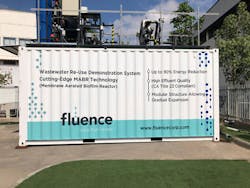Fluence commissions first MABR system in mainland U.S.
MELBOURNE, AUSTRALIA & NEW YORK, oct 31, 2017 -- Fluence Corporation Limited has signed an agreement with Stanford University to deploy, test and evaluate the Company’s MABRwastewater treatment technology at Stanford’s Codiga Resource Recovery Center (CR2C).
The Fluence MABR unit is expected to be operational at CR2C’s test facility as early as January 2018. The installation introduces MABR to the continental United States, and California specifically, where there is a high demand for wastewater treatment technology. The agreement follows the MOU the parties executed earlier in 2017.
The MABR unit will allow CR2C faculty and research students to conduct independent evaluations of the MABR wastewater treatment technology and processes.
"Fluence’s innovative MABR technology as a reuse solution solves the water scarcity problem efficiently and cost-effectively in the U.S., specifically in California," said Henry Charrabé, Fluence’s Managing Director and CEO. "Especially in regions where power is at a premium, our smart packaged decentralized MABR units produce the highest quality output while minimizing power consumption, operation and maintenance costs."
RELATED: VIDEO: MABR tech is “moving the needle” - Henry J. Charrabé, CEO of Fluence Corp
This is the second MABR unit deployed in the United States, and the first on the mainland. The first MABR plant was built and commissioned at the end of last year in Bordeaux, St. Thomas, US Virgin Islands. The Bordeaux plant, which has been in operation for almost one year, received approval from the Environmental Protection Agency in May 2017. The plant was fully operational within a few hours of Hurricane Irma striking the island, reflecting the technological reliability and robustness of the MABR unit.
